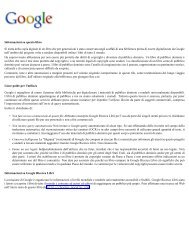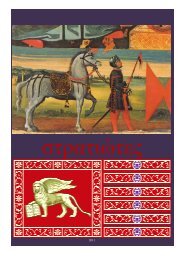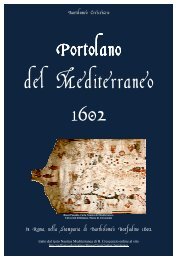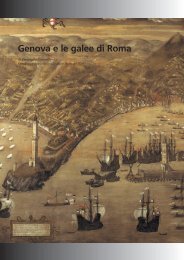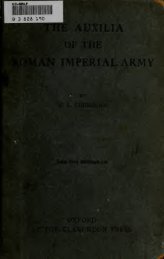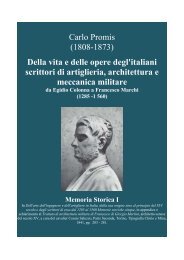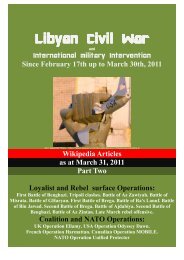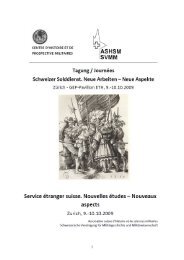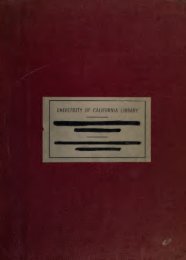96 SMITHSONIAN STUDIES IN HISTORY AND TECHNOLOGYsource. The description of a havelock given in STEVENS,Berdan's U.S. Sharpshooters, p. 5, is completely at variancewith the generally accepted definition of the term.'"On this, see OQMG, LS, Clothing, 1861-1865, RG92, NA.""For the contracts, see Exec. Doc. 84, 38th Congress,2d Session, House; U.S. WAR DEPARTMENT, ARQMG,1864.""U.S. WAR DEPARTMENT, ARQMG, 1865, pp. 209, 211."' As regards the officers, it must be remembered that the1861 uniform regulations, paragraph 1494 stated: "Commissionedofficers may [italics added] wear forage caps ofthe same pattern" [as the enlisted men], so there was no compulsionto wear the issue item. For enlisted men wearing the"McClellan," see BILLINGS, Hardtack and Coffee, p. 307.Just when and by whom this cap was first called the "McClellan" is unknown."' For comparison, see Illustrated Catalogue of Arms andMilitary Goods, p. 48."" On this, see MARGERAND, "Les coiffures de I'armeefrancaise," in Revue, No. 3 (June 1909), plate 8: figs. 4,5, 7, 8. Unfortunately, Margerand's text gives no measurementsfor these particular caps.'^"ToDD, in his Cadet Gray (p. 73), speaks of the "blueChasseur model" as having been adopted in 1861. He seemsto be in error ,as to the date of change. Photographs ofmembers of the class of 1857 show cadets wearing bothtypes. For the 1839 pattern see photograph of Cadet SamuelFerguson, class of 1857. For the chasseur pattern, seephotographs of Cadet William Sinclair, class of 1857 andW. Hemphill Bell, class of 1858, Cadet Orlando G. Wagner,class of 1859 and Cadet John Herbert Kelley, class of 1861but resigned in 1860. Photographs in files of SmithsonianInstitution. The 1857 USMA regulations merely describethe cap as "according to the pattern deposited with thequartermaster at West Point.""' See <strong>United</strong> <strong>States</strong> <strong>Army</strong> and Navy Journal, 4 January1868, p. 315, and 28 March 1868, p. 506.'" <strong>United</strong> <strong>States</strong> <strong>Army</strong> and Navy Journal, 20 February1869, p. 432. Also see advertisements in issues for 30 July1870, 6 August 1870, and 13 August 1870.'" HEITMAN, Historical Register and Dictionary of the<strong>United</strong> <strong>States</strong> <strong>Army</strong>, vol. 1, p. 444.'" U.S. WAR DEPARTMENT, Regulations for the Uniformand Dress of the <strong>Army</strong>.'" Uniform Regulations for the <strong>Army</strong> of the <strong>United</strong> <strong>States</strong>,1861, pp. 13-14; Quartermaster Manual, 1865, p. 15. Actually,the size of the letter for the forage cap is not given ineither citation, the one-inch size being that given the letterfor wear on the campaign hat.''" Uniform Regulations for the <strong>Army</strong> of the <strong>United</strong><strong>States</strong>, 1861.'" For details of the officers' insignia, see pp. 14 above.'" On this see PELADEAU, "U.S. Sharpshooter Hat Insignia,"Military Collector and Historian, vol. 19, no. 3 (Fall1962), pp. 92-94.'"" For this, see MADAUS, "Notes on the Uniform of Berdan'sSharpshooters.""'"For Kearny's order and that of the 1st Div., 9th Corps,see WiKE, "The Wearing of <strong>Army</strong> Corps and Division Insigniain the Union <strong>Army</strong>, 1862-1865." Wike does not citethe location of the first two orders, but has stated to theauthor that he copied them from the originals in the NationalArchives when he was employed there many yearsago. For the <strong>Army</strong> of the Potomac order, see unnumberedcircular. <strong>Army</strong> of the Potomac, 21 March 1863, in U.S. WARDEPARTMENT, The War of the Rebellion, series 1, vol. 25,part 2, p. 152.'" Ibid."'During the Civil War a number of "Hght" batterieswere converted to "horse" artillery, with all personnelmounted, and grouped into "horse artillery brigades," whichoperated in direct support of cavalry operations. On this,see DYER, A Compendium of the War of the Rebellion, vol.3, pp. 1693-1709, and BIRKHIMER, Historical Sketch ofthe Organization, pp. 70-72. Actually, as late as 1942 the82nd Field Artillery Battalion and the 61st Field ArtilleryBattalion, direct support elements of the 1st Cavalry Division,were "horse" units, or "animal mounted" as <strong>Army</strong> Regulationsthen called them, all personnel being individuallymounted. On the other hand, as late as 1942 the 6th FieldArtillery Battalion, then a G.H.Q. reserve unit, was "horsedrawn,"or "animal drawn" as the regulations called it, withsome personnel being individually mounted and the remainderriding the caissons and limbers. On the two modernterms, see AR 600-40, WD, 28 August 1941, RG 94, NA.Today the "field artillery," which accompanies the army inthe field, includes materiel of very heavy calibers becauseof modern means of transportation.'"' Unless otherwise stated, the material in this section istaken from BIRKHIMER, Historical Sketch of the Organization,pp. 54—74."'Ringgold to Jessup, 10 February 1839, OQMG, Reg.LR, Clothing, RG 92, NA; Ringgold to AG, 19 October1839, AG Reg. LR, RG 94, NA.'"=G.O. No. 36, HQ of A, 21 June 1839, RG 94, NA.Although the AG, in writing to Jessup in August 1844,stated that the Secretary of War had authorized red horsehairplumes and bands in November 1842, in May 1841 theCommissary General of Purchases, Callander Irvine, haddirected the Military Storekeeper at Philadelphia to issueto Ringgold's Company "C," 3d Artillery, 71 red horsehairplumes. See AG to Jesup, 5 August 1844, AG, LS, RG 94,NA; Irvine to Fayssoux, MSK at Philadelphia, Supply OrdersIssued to QM and MSK at Philadelphia, 1813-1843,RG 92, NA.""Uniform Board Report, 27 April 1844, AG Doc. File,B 136, 1844, Box 150, RG 94, NA. This report is very difficultto use; notations added on the margin, apparently bythe Quartermaster General to whom it was routed by theAG, (to ascertain whether or not certain recommendationswere approved) are almost illegible.'"'Jesup to Judd, 11 April 1844, OQMG, LS, Clothing,RG 92, NA; Jesup to Scott, 13 April 1844, OQMG, LS,Clothing, RG 92, NA.'"'The Ringgold uniform is discussed in depth in KLOSTER, <strong>United</strong> <strong>States</strong> <strong>Army</strong> Uniforms to 1854, vol. 3.'""Sibley (for Jesup) to Lt. H. W. Clossen, 1st Arty., 20June 1859, OQMG, LS, Clothing, RG 92, NA; Col. CharlesThomas, Asst. QM at Phila., to Jesup, 22 April 1859,
NUMBER 3097OQMG, Reg. LR, Clothing, RG 92, NA.""G.O. No. 54, HQ of A, 15 December 1845, RG 94,NA.'"'G.O. No. 1 WD, 30 January 1854; see OQMG, LS,Clothing, RG 92, NA, for the period 1854-1858 for numerousdirectives to the Philadelphia Depot for such issues.'"'Sibley (for Jesup) to Maj. H. C. Wayne, Asst. QM,Phila., 25 September 1857, OQMG, LS, Clothing, RG 92,NA.'"'Jesup to Thomas, Phila., 25 October 1858 and 25January 1859, both OQMG, LS, Clothing, RG 92, NA.'"'Ibid.; Jesup to Thomas, Phila., 23 December 1858 andJesup to Capt. Van Vliet, Ft. Leavenworth, 23 November1858, both OQMG, LS, Clothing, RG 92, NA.'""See Jesup to Thomas, Phila., 29 January 1859, OGMG,LS, Clothing, RG 92, NA.'""G.O. No. 20 WD, 6 August 1860, RG 94, NA.'"' See MCBARRON AND TODD, "U.S. Light Artillery Companies,Dress, 1857-1872." The Uniform Regulations of1861 clearly stated: "For Companies of Artillery equippedas Light Artillery, the old pattern uniform cap, with redhorsehair plume, cord and tassel."'""On this, see Thomas to Jesup, 22 April 1859, OQMG,Reg. LR, Clothing; Sibley (for Jesup) to Lt. H. W. Closson,1st Arty., 20 June 1859, OQMG, LS, Clothing; Sibley (forJesup), to Lt. Henry Benson, 2d Arty., 29 Sept. 1859,OQMG, LS, Clothing; all RG 92, NA.'""Sibley (for Jesup) to Thomas, 25 June 1859, OQMG,LS, Clothing, RG 92, NA.""See note 166 and Sibley (for Jesup) to Thomas, 6April 1860, OQMG, LS, Clothing, RG 92, NA. Whetherthe caps issued were the original 1851 pattern with the redband or the 1854 pattern with merely the red welt on thedark blue band is unknown.'"LORD, Civil War Collector's Encyclopedia, p. 305.Unfortunately, Lord does not give his source in this instance.'"Crosman to Capt. Martin, MSK, 24 September 1863,press copies of LS, Depot QM, Phila., RG 92, NA. Theunit was apparently the "23d Independent Battery LightArtillery." See DYER, A Compendium of the War of theRebellion, vol. 3, p. 1401.'"Capt. A. J. Perry (for Meigs) to Lt. Henry, 7 Nov.1863, OQMG, LS, Clothing, RG 92, NA; Uniform Regulationsfor the <strong>Army</strong> of the <strong>United</strong> <strong>States</strong>, 1861, pp. 12-13."^ Perry (for Meigs) to Vinton, 11 December 1863,OQMG, LS, Clothing, RG 92, NA.""Vinton to OAC & E, Phila., Reg. LR, OAC & E, 14December 1863, RG 92, NA."* Statements of Clothing and Equipage on Hand or Duefrom Contracts, 1860-1864, RG 92, NA. There were 1195on hand on 31 January 1864.'" Contract with Dare in Branch E, Regular Supplies,Contracts, Box 50, RG 92, and in RG 217; contract withHorstmann in Branch E, Regular Supplies, Contracts, Box102, RG 92; all NA.'" Statements of Clothing and Equipage on Hand or Duefrom Contracts, 1860-1864, RG 92; Registers of ContractsRelating to the Supplying of Clothing and Equipage, August1862-November 1874, RG 92; both NA. Although theseregisters cover only the activities of the Philadelphia Depot,no contract for these caps let by either the New York Depotor the Cincinnati Depot has been found. Although by lawall <strong>Army</strong> contracts were to be reported to the Congress andpublished in executive documents, there are gaps in suchduring the Civil War period."° For an excellent discussion of the contract system usedduring the Civil War, see RiscH, Quartermaster Support ofthe <strong>Army</strong>, pp. 338-357 and esp. p. 353."" See OQMG, LS, Clothing, 1863-1864, RG 92, NA."'Meigs to Vinton, 27 April 1864, OQMG, LS, Clothing;Vinton to OAC & E, Phila., 29 April 1864, Reg. LR, OAC& E; both RG 92, NA. Why New Orleans requisitioned somany of these caps is unknown. As of June 1865, 1500 ofthem were reported as still being on hand at that depot.See U.S. WAR DEPARTMENT, ARQMG, 1865, p. 81."'Meigs to Crosman, 7 June 1864, OQMG, LS, Clothing,RG 92, NA."'Crosman to Meigs, 8 June, 13 June, 1864, OQMG,Reg. LR, Clothing, RG 92, NA."•"CO. No. 220 WD, 1 July 1864, RG 94, NA."^Report of board of officers established by S.O. No. 31,HQ of A, 11 February 1862, AGO, LR, 216-B-1862, RG94, NA.'*" Illustrated Catalogue of Arms and Military Goods, p. 48."' Although the introduction to Uniform Regulations forthe <strong>Army</strong> of the <strong>United</strong> <strong>States</strong>, 1861, dates the photographsas 1861 or 1862, the dating error that was discovered somemonths after publication was corrected in an annotated notein Military Collector and Historian, vol. 19, no. 3 (Fall1962), pp. 91-92."' Actually, the issues directed by OQMG were confinedto elements of the 3d Arty at Ft. Trumbull, Conn., and ofthe 2d Arty at Ft. McHenry, Md., where the units wererefilling depleted ranks. See Meigs to Vinton, NY, 15August 1864; Meigs to Perry, Phila., 28 September 1864;Meigs to Col. Biggs, Phila., 23 November 1864; Meigs toBiggs, 13 and 17 December 1864; Meigs to Col. McKim,Phila., 7 April 1865; all OQMG, LS, Clothing, RG 92, NA.Regarding restrictions on issues of the cap, see Meigs toMaj. Fred Walker, <strong>Army</strong> of the Tennessee, 8 December1864, and Meigs to Capt. Bowman, Baltimore, 17 December1864, both OQMG, LS, Clothing, RG 92, NA.'^"Exec. Doc. No. 84, 38th Congress, 2d Session, House;ARQMG, pp. 72-73, 85.'""Act of 28 July 1866, as quoted in SPAULDING, The<strong>United</strong> <strong>States</strong> <strong>Army</strong> in War and Peace, p. 340; G.O. No. 139WD, 28 September 1865, RG 94, NA.'"'Act of 3 March 1869, and G.O. No. 6, HQ of A,February 1869, RG 94, NA.'"' On these issues, see OQMG, LS, Clothing, RG 92, NAfor the period. For the prohibition on issue to other thanmounted batteries, see Perry (for Meigs) to Col. Brooks,Ft. McHenry, Md., 29 October 1867, OQMG, LS, Clothing,RG 92, NA. There are numerous other references tothis prohibition in OQMG, LS, Clothing, all the way to1872.'"' For these photos see Military Collector and Historian,vol. 15 (Spring 1963), p. 21, and vol. 16 (Summer 1964),p. 52.'"'On this, see OQMG, LS, Clothing, RG 92, NA, for
- Page 1:
• ^ - :lP-'L^ry\'^ ^iT
- Page 4 and 5:
ABSTRACTHowell, Edgar M. United Sta
- Page 7 and 8:
ContentsPagePrefaceiiiThe 1855 Cava
- Page 9 and 10:
United States Army Headgear 1855-19
- Page 11 and 12:
NUMBER 30report, stated: "The hat p
- Page 13 and 14:
NUMBER 30acorns %g inches long and
- Page 15 and 16:
NUMBER 30the pattern." The rate of
- Page 17 and 18:
NUMBER 30FIGURE 3.—1858 Army hat.
- Page 19 and 20:
NUMBER 3011model, number 60 in the
- Page 21 and 22:
NUMBER 30 13"the desired modificati
- Page 23 and 24:
NUMBER 30 15the sun in the top. The
- Page 25 and 26:
NUMBER 30 17FIGURE 8.—1858 forage
- Page 27 and 28:
NUMBER 30 19Hardtack and Coffee, ca
- Page 29 and 30:
NUMBER 3021FIGURE 11.—a, Brigadie
- Page 31 and 32:
NUMBER 30 23short "shell" jacket "f
- Page 33 and 34:
NUMBER 30 26broad, securely soldere
- Page 35 and 36:
NUMBER 30 27worn in the picture wer
- Page 37 and 38:
NUMBER 30 29This communication elic
- Page 39 and 40:
NUMBER 30 31FIGURE 17.—"The [Scot
- Page 41 and 42:
NUMBER 30 33time for issue in the c
- Page 43 and 44:
NUMBER 30 35be at too great a dista
- Page 45 and 46:
NUMBER 3037half (5/2) part of washb
- Page 47 and 48:
NUMBER 30 39trimmings for all enlis
- Page 49 and 50:
NUMBER 30 41ing the upper space for
- Page 51 and 52:
NUMBER 30rear one to a correspondin
- Page 53 and 54: NUMBER 30 46FIGURE 29.—1872 enlis
- Page 55 and 56: NUMBER 3047FIGURE 32.—^The Bent &
- Page 57 and 58: NUMBER 3049of strong split-leather
- Page 59 and 60: NUMBER 30 51''""MttfenFIGURE 35.—
- Page 61 and 62: NUMBER 30 53(which he thought might
- Page 63 and 64: NUMBER 30 55FIGURE 38.—Captain Be
- Page 65 and 66: NUMBER 30 57campaign hat for the Ar
- Page 67 and 68: NUMBER 30 59salvage something from
- Page 69 and 70: NUMBER 30 61hat. In June 1899 the P
- Page 71 and 72: NUMBER 3063the left side, pass diag
- Page 73 and 74: NUMBER 30 65.LJU^.."*^..FIGURE 44.
- Page 75 and 76: NUMBER 30 67to be sent to Washingto
- Page 77 and 78: NUMBER 30 69with brass sliding-buck
- Page 79 and 80: NUMBER 30 71FIGURE 48.—Officers'
- Page 81 and 82: NUMBER 3073The adoption of the whit
- Page 83 and 84: NUMBER 3075i >•^\Wiii I ifiiiniim
- Page 85 and 86: NUMBER 30this last model made no pr
- Page 87 and 88: NUMBER 30 79WAR DEPARTMENT,QUARTERM
- Page 89 and 90: NUMBER 3081FIGURE 58.—1864 chapea
- Page 91 and 92: NUMBER 30geon 1880 and Surgeon Gene
- Page 93 and 94: NUMBER 3085FIGURE 63.—1895 forage
- Page 95 and 96: NUMBER 30 87of not less than 9.24 g
- Page 97 and 98: AppendixMAKERS OF HEADGEARThe chron
- Page 99 and 100: List of AbbreviationsAAGAAQMAGAGOAQ
- Page 101 and 102: NUMBER 3093all OQMG, LS, Clothing,
- Page 103: NUMBER 30 95"Jesup to Thomas, 8 Dec
- Page 107 and 108: NUMBER 30 99October of 1870. See Me
- Page 109 and 110: NUMBER 30 101'"* See above, pp. 35-
- Page 111 and 112: NUMBER 30 103Monroe, Va., in 1878.
- Page 113 and 114: NUMBER 30 105""Endorsement, 24 May
- Page 115 and 116: ReferencesThe bulk of the source ma
- Page 117: M MBIiR 30 10910, No. 355-10, 19 Se



